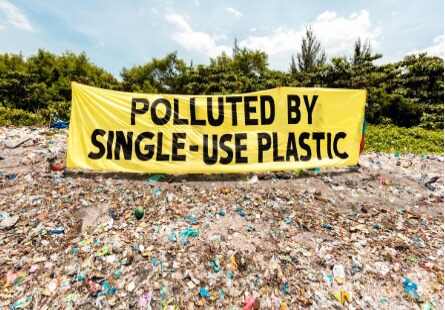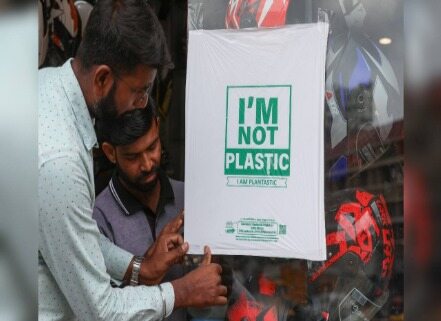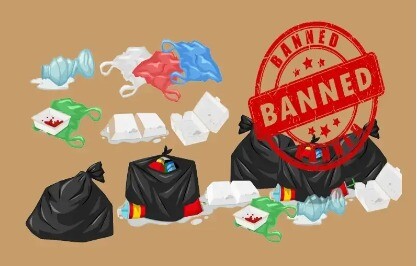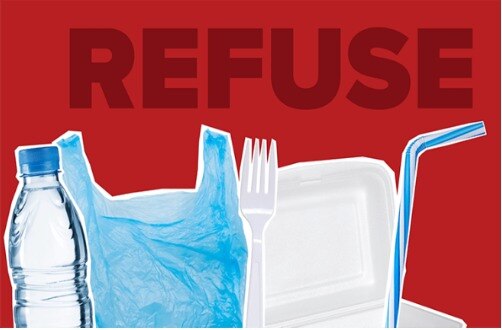Single-use plastics (SUP) denotes a plastic item designed for one-time use before disposal or recycling. It encompasses a wide range of products, including packaging, bottles, bags, face masks, coffee cups, cling films, and more. If the current production trend persists, SUP could contribute to 5-10% of greenhouse gas emissions by 2050.
India pledges to eliminate Single-Use Plastics by 2022. However, obstacles remain despite some advancements such as prohibiting certain SUP items. A report released during the 6th United Nations Environmental Assembly (UNEA-6) highlights that India’s vibrant street food industry heavily relies on SUPs.
Key highlights of the report
The UNEA-6 report highlights significant points regarding Single-Use Plastics. They are:
- India’s street food industry relies heavily on single-use plastics like plates, bowls, cups, and containers, exacerbating waste management challenges despite their cost-effectiveness.
- The report emphasises the benefits of a reusable system, including reduced cost for vendors and customers, decreased waste generation, and the potential for a 21% return on investment within 2-3 years.
- Factors such as material selection, duration of use, return rates, deposit amounts, and government incentives are critical for optimizing the effectiveness of the reusable system.
Overall, transitioning to a reusable packaging model in India’s street food sector offers a mutually beneficial solution. It drives economic savings and addresses environmental concerns, fostering resilience and sustainability in Indian urban settings.
The current landscape of SUP
India implemented a ban on 19 specific single-use plastic items in 2021, yet the broader spectrum of SUPs remains largely unaddressed. Annually, approximately 0.6 million tonnes of banned SUP items are still in circulation. The remaining single-use plastic products, mainly packaging materials, are subject to the Extended Producer Responsibility (EPR) policy introduced by the Ministry of Environment, Forest and Climate Change (MOEFCC) in 2022.
However, the EPR policy overlooks the fact that certain non-banned single-use plastics are non-recyclable. According to the Plastic Waste Makers Index 2019, India ranked 13th globally in SUP polymer production investment. It stands as the 3rd largest contributor to SUP waste globally, generating 5.5 million tonnes annually. Despite this, India ranks 94th in per capita SUP waste, averaging 4 kg annually.

This suggests that India’s single-use plastic ban addresses only around 11% of the total SUP waste generated. UNER’s data on plastic waste management reveals that India mismanages 85% of its plastic waste, predominantly, SUP. This waste is often dumped or incinerated along roadsides, leading to clogged drains and pollution of rivers and degrades into micro-and nono-sized plastics, posing a significant threat to marine life.
Challenges in tackling SUP
Navigating the challenges associated with single-use plastics entails addressing various complexities. Firstly, the search for viable alternatives is hindered by limited accessibility and cost-effectiveness. Secondly, economic considerations pose obstacles, as the affordability and convenience of single-use plastics discourage investments in alternative solutions.
Additionally, inadequate waste management infrastructure exacerbates plastic pollution, particularly in regions with limited resources. Policy implementation faces hurdles due to enforcement difficulties and resistance from industries and consumers. Furthermore, altering consumer behaviour requires concerted efforts to raise awareness and change ingrained habits. Lastly, any measures to phase out SUPs must carefully consider their socio-economic impacts, ensuring support for affected individuals and communities.
Measures ahead
To effectively address the challenge of single-use plastics, various actions can be taken. Firstly, there’s a need to strengthen law enforcement by enhancing the capabilities of officials responsible for issuing penalties and providing them with essential tools such as gauge meters. It is essential to ensure thorough reporting on inspection activities across different facilities. Furthermore, promoting transparency in environmental compliance is crucial.
This involves mandating the Central Pollution Control Board (CPCB) and the Ministry of Environment, Forest and Climate Change (NOEFCC) to require local governments and states to regularly update their websites with information on environmental compensation, facility closures, and fines imposed. Additionally, the CPCB should integrate this data into its Annual Report in alignment with the Plastic Waste Management Rules, 2016, and share insights gathered from both private entities and state authorities.
Also, Putting an end to the micron business involves banning carry bags regardless of their thickness, a strategy successfully implemented in economically weaker countries such as Tanzania and Rwanda. Himachal Pradesh, an Indian state, exemplify this approach through the comprehensive ban enacted under the Non-biodegradable Garbage Control Act of 1998, effectively eliminating the production, distribution, storage, and usage of such bags across the entire state. Concurrently, addressing the scarcity of alternatives to single-use plastics requires investment in sustainable alternative markets.

How other countries are dealing with this?
Other countries are taking action to address single-use plastics through various measures. In 2022, a resolution was signed by 124 countries, including India, at the United Nations Environment Assembly. This resolution aims to create a legally binding agreement for signatories to manage the entire life cycle of plastics, from production to disposal, to combat plastic pollution effectively.
Additionally, as of July 2019, 68 countries have implemented bans on plastic bags, with enforcement levels varying across different regions. Bangladesh was the pioneer in banning thin plastic bags in 2002. New Zealand joined the effort by implementing a ban on plastic bags in July 2019, becoming one of the latest countries to do so. China followed suit with a ban on
plastic bags in 2020, implementing it gradually over time. In the United States, eight states have enforced bans on single-use plastic bags, starting with California in 2014.
Additionally, Seattle emerged as the first major city in the US to prohibit plastic straws in 2018. In July 2021, the European Union (EU) implemented the Directive on SUPs. This directive prohibits specific use of single-use plastics, including items like pates, cutler, straws, balloon sticks, and cotton buds, for which alternative option exists. These banned items are not permitted to be sold in EU member states. Additionally, the directive extends to cups, foods and beverage containers made of expanded polystyrene, and all products composed of oxo-degradable plastic.

Conclusion
India’s endeavour to combat single-use plastics requires a collaborative approach from policymakers, industry players, and citizens. Despite progress, challenges remain in enforcement, awareness, and infrastructure. Encouraging research and investment in innovative alternatives, promoting recycling and waste management practices and empowering communities with education and resources are some essential components.
Moreover fostering collaboration between government bodies, businesses, and civil society organizations can enhance the effectiveness of initiatives aimed at reducing plastic waste Embracing sustainable alternatives and implementing proactive strategies can help India address the negative effects of single-use plastics and move towards a more environmentally friendly future.
-TANYA SHAH
MUST READ: NANO PLASTICS IN BOTTLED WATER: 10 TIMES WORSE THAN ONCE THOUGHT





